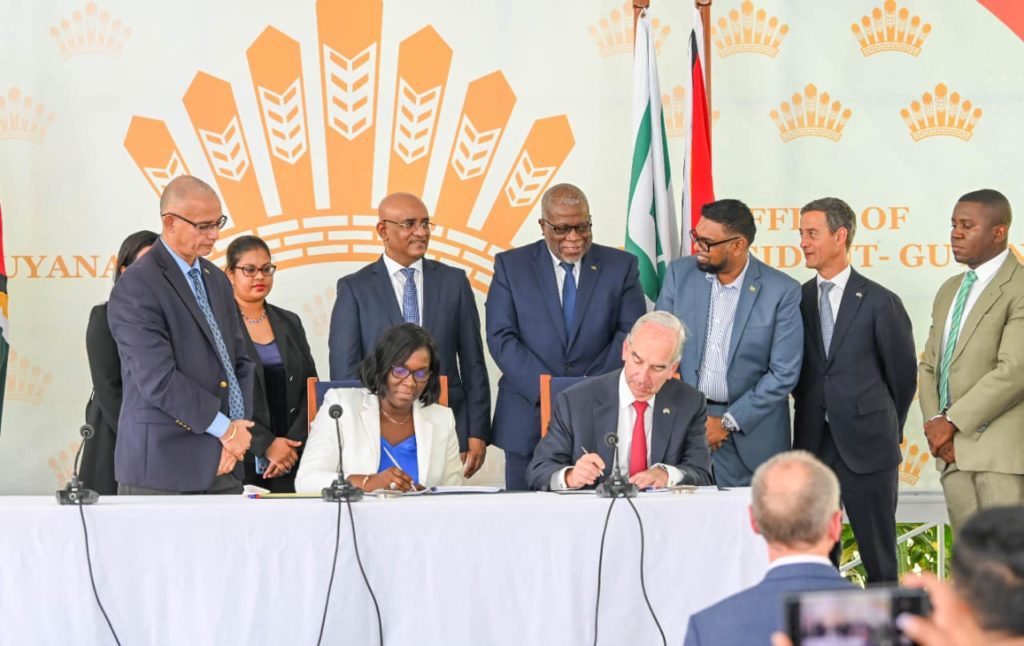COP28: Disappointment for Guyana as carbon market talks fail to advance
By Vishani Ragobeer
Dubai was at the centre of global conversations and negotiations on the climate crisis with this year’s United Nations climate change conference, COP28, hosted there.
A major agreement to transition away from fossil fuel use has been seen as the highlight of the talks but if you ask Guyana’s Vice President Dr. Bharrat Jagdeo, there were many disappointing outcomes of the conference.
Guyana’s main disappointment, according to him, was the lack of progress on developing carbon markets. It hoped that its carbon credits would be part of a central compliance market where trading could generate higher prices for Guyana, and that there would be a new mechanism for bilateral trading between countries.
“We thought that advancing the carbon markets would create greater incentives to ensure that countries that are forested can raise money through the market mechanism to outcompete alternate use and therefore preserve their forests without taking away their forests as a development tool,” Jagdeo said at a press conference he hosted one day after the end of COP28.
At the end of COP28, countries failed to reach an agreement on frameworks that deal with carbon markets. Confidentiality agreements, common standards and controls for carbon trading were among the topics countries differed on.

The European Union, the News Room understands, was firm about high standards for carbon trading during the COP28 negotiations though others, including Guyana, believe onerous standards would constrain the development of carbon markets.
Jagdeo, while in Dubai for COP28, told the News Room that the focus on firm standards or strict rules for countries getting involved in carbon trading must be reasonably pursued.
“Standards are important but the talk about standards must not be used as an excuse for killing the market.
“… We believe you can work through those issues instead of avoiding the development of the market,” he explained.

For context, carbon markets fall under Article 6 of the Paris Agreement which is a legally-binding international treaty on climate change. And the Article, the World Bank stated in a 2022 explainer piece, allows countries to voluntarily cooperate with each other for emission reduction targets as identified in their national climate plans called Nationally Determined Contributions (NDC).
Article 6.2 of the Agreement deals with bilateral (or country to country) trading of carbon credits. Through this, countries can decide their guidelines for trading credits. Article 6.4 focuses more on the creation of a global carbon market that would be overseen by a body of the United Nations Framework Convention on Climate Change (UNFCCC), which is the body that pulled off COP28 and all other COPs. Article 6.8- an aspect that hasn’t gotten much attention during the negotiations- deals with non-market approaches to the carbon trade.
Carbon markets generally work by allowing countries with carbon credits (like Guyana, for example) to trade those to other countries or even companies (as has been the case with Guyana and the Hess corporation). There are voluntary and compliance markets.

And a carbon credit is a kind of tradable permit or certificate that represents the removal of a certain amount of carbon dioxide, a harmful greenhouse gas that contributes to global warming, from the environment. Trees naturally trap that carbon dioxide. Guyana’s 18.5 million hectares of trees trap about 154 million tonnes of carbon dioxide, a sum equivalent to about 18% of the world’s total forest carbon.
Despite little progress on Article 6.2 and 6.4, Guyana is moving ahead with its existing carbon market venture in the voluntary market. Already, 30% of all of Guyana’s credits, which are jurisdictional credits with ART TREES certification, have been sold to the American oil company, Hess Corporation. That’s a deal worth at least US$750 million up to 2030.
Jagdeo said at his press conference that Guyana believes it can earn about US$2.5 billion if it markets the remaining 70% of credits with the prices it has already secured.
Of all the carbon credits funds Guyana gets, it is a matter of national policy that a designated 15% is disbursed to the more than 200 Indigenous communities across the country in recognition of their forest stewardship. The remaining revenues- the 85%- is for Guyana’s climate adaptation needs, be it beefing up sea defences to protect against rising sea levels or improving agricultural systems.
But other countries, Jagdeo opined, aren’t as lucky as Guyana.
“A lot of very good countries with good policies in Africa surrounding the forests (and) preserving the forests, are not going to get the financing like we got.
“They are working within the framework of the UN system and unfortunately, it would delay these countries getting resources which they should get because they perform a service for the global community,” he lamented.
It hasn’t been all rosy for carbon markets. Concerns have been raised over whether credits actually help with emissions reduction or they just give buyers a pass to keep emitting. These markets have also been subject to much more scrutiny over the past year following investigations from the United Kingdom (UK) Guardian, for example.
Still, many back carbon markets as a necessary tool in the fight against climate change.
President of the European Commission (EU) Ursula von der Leyen, for one, believes that carbon markets can help reduce greenhouse gas emissions if used correctly.
“Put a price on carbon. The message is very clear: You are polluting; you must pay a price. You want to avoid the payment? Then innovate and decarbonise.
“Carbon pricing nudges the private sector towards innovation. It makes heavy polluters pay a fair price and the revenues can be reinvested in the fight against climate change, in innovation and in a just transition,” she said at a COP28 high-level event on carbon markets.
For such a system to work, however, the price for carbon must be high enough to deter countries or companies from shelling out dollars just to keep emitting. That’s part of why Guyana wants to benefit from the Article 6 system; it is believed that there would be higher prices for carbon credits there.
With the talks on the Article 6 system moved to next year, however, Guyana has its national scheme to fall back on in the meantime.
For more than two decades, Guyana has been championing forest payments as a way of helping forested countries like itself keep their trees alive. Jagdeo himself led these efforts. In 2009, when he was President, he managed to sign a US$220 million deal with Norway to do just that.
Now, more than two decades later, he believes saving the trees still isn’t given enough importance despite a much greater recognition that they are essential in the fight against climate change.
Importantly though, Jagdeo said Guyana isn’t in any rush to sell the remainder of its credits.
This story was published with the support of Climate Tracker through the COP28 Climate Justice Reporting Fellowship.






